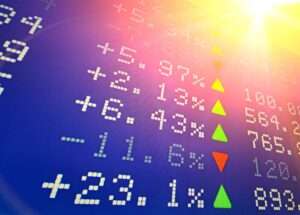Introduction to Virtual Reality
In today’s rapidly evolving technological landscape, virtual reality (VR) and augmented reality (AR) are emerging as transformative forces across various industries. One area where their influence is increasingly significant but often overlooked is the world of forex markets. As these advanced technologies continue to gain momentum, they are reshaping the forex landscape by influencing economic factors such as tech industry growth, investment flows, and changes in consumer behavior. This article aims to examine the economic impact of VR and AR advancements on forex markets and explore the intricate web of relationships that connect these seemingly disparate realms.
The Rise of VR and AR Technologies
The evolution of Virtual Reality (VR) and Augmented Reality (AR) technologies has been nothing short of revolutionary. To fully comprehend their profound influence on forex markets, let’s take a deeper dive into the rapid progression of these transformative technologies.
VR and AR Unveiled: A Technological Marvel
At their core, VR immerses users in computer-generated environments, creating a sensory experience that often feels incredibly realistic. In contrast, AR enhances the real world by overlaying digital information onto our physical surroundings. This dichotomy offers a wide spectrum of possibilities for enhancing human experiences and interactions with the digital realm.
The rapid advancement of VR and AR can be attributed to ongoing innovations in hardware, software, and content creation. In terms of hardware, we have witnessed the development of high-resolution displays, ergonomic headsets, and sophisticated motion-tracking systems. These improvements have culminated in more immersive and comfortable user experiences, pushing the boundaries of what was previously thought possible.
On the software front, the capabilities of VR and AR applications have expanded exponentially. Developers have created increasingly sophisticated and realistic virtual worlds, educational simulations, medical training modules, and entertaining experiences that transcend the realm of gaming and entertainment. The richness and diversity of content have been instrumental in broadening the appeal and utilization of VR and AR technologies.
Read our latest article on Global Smart City Projects

Beyond Gaming and Entertainment: A Global Phenomenon
No longer confined to the realms of gaming and entertainment, VR and AR have embarked on an ambitious journey into various industries, each benefiting from their unique capabilities.
- Healthcare: In the healthcare sector, these technologies have revolutionized medical training and patient care. Surgeons can practice complex procedures in virtual environments, minimizing risks associated with real-world surgeries. Patients can also benefit from VR-based therapies, aiding in pain management, rehabilitation, and mental health treatment.
- Education: VR and AR have enriched educational experiences by offering immersive learning environments. Students can explore historical sites, dive into complex scientific concepts, or even interact with virtual wildlife, enhancing comprehension and retention.
- Real Estate: The real estate industry has embraced these technologies to provide virtual property tours, enabling potential buyers to explore properties from the comfort of their homes. This not only saves time but also broadens the reach of real estate listings to a global audience.
- Military and Defense: The military has found applications in training, mission planning, and even battlefield simulations. Soldiers can practice tactical maneuvers and scenario-based exercises in a safe and controlled virtual environment.
This remarkable expansion across diverse sectors has catalyzed a surge in the adoption of VR and AR technologies. However, their transformative impact extends far beyond individual industries.
The Economic Ripple Effect: Investment and Research
As VR and AR continue their pervasive integration, their growth has ignited substantial investment and research efforts across the globe. Large technology companies like Facebook (now Meta), Google, Microsoft, and Apple have recognized the potential of these technologies to revolutionize various facets of human life. In response, they have allocated significant resources to accelerate research, development, and commercialization efforts.
Venture capital firms, too, have been eager to support startups in the VR and AR space, further fueling innovation and market growth. This surge in investment has a profound ripple effect on forex markets.
The Forex Connection: Investment Flows and Currency Impact
The substantial investments in VR and AR technologies generate flows of capital that crisscross the globe. Tech giants and startups, receiving funding from international investors, engage in global operations, transactions, and collaborations. This increased international business activity inevitably leads to heightened demand for foreign exchange services.
The effect is two-fold. Firstly, the forex market experiences fluctuations in currency values as investment flows in and out of different regions, impacting exchange rates. Savvy forex traders closely monitor these trends, seizing opportunities and mitigating risks as currency values shift in response to investment dynamics.
Secondly, as tech companies expand into new markets and forge international partnerships, they generate revenue in various currencies. This revenue necessitates effective currency exchange strategies to manage international financial operations. As a result, forex markets play a pivotal role in providing the essential tools and services that support businesses operating on a global scale.
The influence of global Virtual Reality (VR) and Augmented Reality (AR) technologies on forex markets extends beyond what initially meets the eye. Their rapid evolution and widespread adoption across diverse industries have set in motion a series of economic consequences that impact currency values, investment flows, and business operations.
While the integration of VR and AR into the global economy presents numerous opportunities for profit and growth, it also brings along challenges and risks. Traders and investors must stay attuned to the ever-changing landscape of these technologies to make informed decisions.
As VR and AR technologies continue to advance and integrate into various facets of our lives, their influence on forex markets is bound to become even more pronounced. It is imperative for market participants to adapt and evolve alongside these transformative technologies, ensuring that they remain agile and responsive to the shifts and opportunities presented by this dynamic landscape.
Tech Industry Growth and Investment Flows
The technology sector, often referred to as the tech industry, stands at the forefront of innovation and progress in the modern world. With advancements in fields like virtual reality (VR) and augmented reality (AR), tech companies have recognized the transformative potential of these technologies, leading to substantial investments in their development. As the tech industry has embraced VR and AR, the resulting growth and investment flows have had profound implications for the global forex markets.
- Tech Industry as a Catalyst for VR and AR Innovation:The tech industry has played a pivotal role in driving the rapid evolution of VR and AR technologies. Companies like Facebook (now Meta), Google, Microsoft, and Apple have not only recognized the potential of VR and AR but have actively invested in research, development, and integration of these technologies into their product portfolios. This strategic focus has accelerated the maturation and accessibility of VR and AR experiences, expanding their applications beyond gaming and entertainment.
- The Surge in Tech Industry Investments:The commitment of tech giants to VR and AR has translated into substantial financial investments. These companies have allocated significant resources to fund research initiatives, acquire innovative startups, and develop cutting-edge hardware and software. This surge in investment has created a virtuous cycle, driving continuous innovation and increasing the global adoption of VR and AR.
- Impact on Forex Markets:The tech industry’s heavy investment in VR and AR has had a cascading effect on forex markets, influencing various aspects of the currency exchange landscape:
- Multi-Currency Transactions: Tech companies, both established giants and startups, often operate on a global scale. Consequently, they engage in multi-currency transactions due to the diverse locations of their operations, partners, and customers. This results in increased demand for foreign exchange services as companies convert funds between various currencies, impacting currency values.
- Monitoring the Tech Industry: Forex traders closely monitor the tech industry because shifts in tech-related investments can create trading opportunities and risks. Sudden injections of capital into VR and AR projects or the announcement of breakthrough developments can lead to currency market fluctuations as traders react to the news.
- International Revenue Generation: Tech companies, particularly the largest players, generate substantial international revenue. As they expand their products and services into new markets, they earn revenue in local currencies. This influx of international earnings can significantly affect exchange rates, as it creates higher demand for the local currency in regions where these companies operate. This impact extends beyond the tech industry itself and can influence the broader forex market.
- Economic Significance of Tech-Driven Forex Impact:The influence of the tech industry on forex markets underscores the economic interconnectedness of global industries. The tech sector’s growth and investment flows not only drive innovation and job creation within the industry but also have far-reaching effects on the global economy. As tech companies continue to invest in VR and AR technologies and expand their international reach, their impact on forex markets is expected to remain a prominent feature of the financial landscape.
In conclusion, the tech industry’s substantial investments in VR and AR technologies have created a symbiotic relationship between the technology sector and forex markets. The multi-currency transactions of tech companies, coupled with their international revenue generation, influence currency values and trading opportunities. As the tech industry continues to thrive and innovate, its impact on forex markets will persist, making it imperative for forex traders and investors to closely follow tech-related developments as they navigate the dynamic world of foreign exchange.
Changes in Consumer Behavior
Cross-Border Business Opportunities
Challenges and Risks
While Virtual Reality (VR) and Augmented Reality (AR) offer a myriad of opportunities for forex markets, they also introduce a set of challenges and risks that participants in the financial sector must navigate. Understanding these complexities is paramount for forex traders and investors as they seek to capitalize on the transformative potential of VR and AR.
1. The Breakneck Pace of Technological Advancement
One of the foremost challenges posed by VR and AR technologies is the relentless pace of their advancement. The VR and AR landscapes are marked by constant innovation, where new hardware, software, and applications are introduced at an astonishing rate. This rapid evolution can present a formidable challenge for forex traders, as staying updated on the latest developments is crucial for making informed decisions.

As VR and AR technologies progress, they may unlock new market opportunities or disrupt existing industries. Forex traders must possess the agility to adapt to these changes swiftly. Failing to do so may result in missed opportunities or unexpected market movements.
2. Intensified Competition in VR and AR Markets
The adoption of VR and AR technologies across a diverse range of industries is leading to fierce competition within these markets. Established tech giants and startups alike are vying for market share and dominance, which can result in dramatic fluctuations in the stock prices of tech companies.
These fluctuations have a direct impact on forex markets, as shifts in the value of tech stocks can influence the overall sentiment and stability of financial markets. Traders must closely monitor these dynamics, as they present both trading opportunities and potential risks.
3. The Need for Continuous Monitoring and Adaptation
The intersection of VR, AR, and forex markets demands continuous monitoring and adaptation. Forex traders and investors need to keep a vigilant eye on developments in the VR and AR sectors, such as product launches, acquisitions, and market trends, to gauge their potential impact on currency values and trading opportunities.
Additionally, traders must be prepared to adapt their strategies in response to changing market conditions. The dynamic nature of both technology and financial markets requires flexibility and the ability to pivot when necessary.
4. Risk Mitigation and Diversification
In the face of these challenges, risk mitigation becomes paramount. Traders and investors can employ a range of risk management strategies, including diversification of their portfolios. Diversifying across various currencies, asset classes, and sectors can help mitigate the impact of volatility resulting from developments in the VR and AR industries.
Furthermore, utilizing protective measures such as stop-loss orders can help limit potential losses in the event of adverse market movements. These risk mitigation strategies are essential tools in the arsenal of forex traders operating in the rapidly evolving landscape shaped by VR and AR.
As VR and AR technologies continue to reshape industries and redefine consumer behavior, forex markets find themselves at the intersection of innovation and risk. The breakneck pace of technological advancement and intensified competition within the VR and AR sectors present both opportunities and challenges for forex traders and investors.
Remaining informed, adaptable, and vigilant is essential in this dynamic environment. Staying updated on the latest developments in VR and AR, monitoring fluctuations in tech stock prices, and employing effective risk management strategies are crucial steps for traders seeking to navigate the transformative impact of these technologies on forex markets. In the ever-evolving landscape of finance and technology, those who can strike a balance between seizing opportunities and managing risks will be best positioned to thrive.
Conclusion
The influence of global virtual reality and augmented reality technologies on forex markets is far-reaching, touching on various aspects of the economy. Tech industry growth, investment flows, changes in consumer behavior, and cross-border business opportunities are just a few of the ways in which VR and AR are shaping the forex landscape. While the integration of these technologies presents opportunities for profit, traders and investors must also be vigilant in managing the challenges and risks associated with this rapidly evolving field. As VR and AR continue to advance, their impact on forex markets is likely to become even more pronounced, making it imperative for market participants to adapt and evolve alongside these transformative technologies.
Read our latest article on Archaeological Discoveries
FAQs
1. How do VR and AR technologies impact forex markets?
- Answer: VR and AR technologies impact forex markets by influencing factors such as tech industry growth, investment flows, and changes in consumer behavior, all of which can lead to shifts in currency values and trading patterns.
2. Why is the rapid pace of technological advancement in VR and AR a challenge for forex traders?
- Answer: The rapid advancement of VR and AR technologies requires forex traders to stay updated on the latest developments to make informed decisions, as these innovations can affect the performance of tech companies and, consequently, currency values.
3. How do businesses adapt their currency exchange strategies in response to changes in consumer behavior driven by VR and AR?
- Answer: Businesses adapt their currency exchange strategies by accepting multiple currencies to cater to international customers who use VR and AR technologies to make purchasing decisions, thereby accommodating the diverse needs of their global clientele.
4. What role do forex market participants play in supporting businesses engaged in cross-border activities facilitated by VR and AR?
- Answer: Forex market participants provide essential tools and services to help businesses manage currency fluctuations in cross-border transactions, offering currency conversion, risk assessment, and hedging strategies to support international ventures.
5. How can currency fluctuations impact the profitability of cross-border business ventures driven by VR and AR?
- Answer: Currency fluctuations can either enhance or erode the value of cross-border transactions, affecting the profitability of international ventures. For example, unfavorable exchange rate movements can lead to reduced revenue or increased costs for businesses.
6. What are the key risks associated with the intensification of market competition in the VR and AR sectors?
- Answer: Intensified market competition can result in significant stock price volatility for tech companies operating in the VR and AR sector, which can, in turn, influence forex market dynamics and create both trading opportunities and risks.
7. How can changes in regulatory policies related to VR and AR impact forex markets?
- Answer: Changes in regulatory policies can impact the valuation and perception of tech companies in the VR and AR sector. These policy shifts may trigger fluctuations in stock prices and influence forex market trends as investors react to regulatory changes.
8. Why is cybersecurity a concern in the context of VR and AR technologies, and how does it relate to forex markets?
- Answer: The immersive nature of VR and AR introduces cybersecurity vulnerabilities. Data breaches or privacy violations can harm tech companies’ reputations, leading to fluctuations in stock prices that can affect forex market sentiment and trends.
9. How can businesses leverage VR and AR opportunities while managing associated risks in forex markets effectively?
- Answer: Businesses can effectively manage risks by staying informed, implementing robust risk management strategies, and seeking the support of forex market participants. Being proactive in monitoring market dynamics and adhering to regulations is crucial.
10. What is the overall impact of VR and AR technologies on forex markets, and how should traders and investors adapt to this evolving landscape?
- Answer: The impact of VR and AR technologies on forex markets is multifaceted, offering both opportunities and risks. Traders and investors should adapt by staying informed, monitoring market sentiment, and employing sound risk management practices to capitalize on opportunities while mitigating potential pitfalls.
Click here to read more on VR and AR


